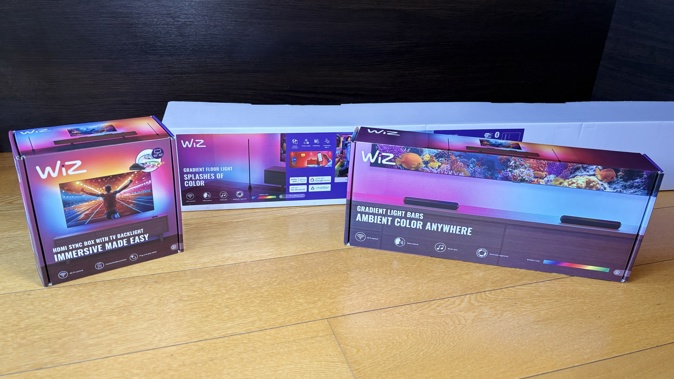
TV backlighting is perhaps one of the more unnecessary bits of tech you can invest in.
As much as I personally love it, it's certainly not something you need, especially given how much it can cost to set up.
Philips Hue has led the way in this department and I recently reviewed its updated 8K Sync Box - a crucial bit of kit you need before you can even start adding actual lights to your system.
Oh... and if you go with Philips Hue, you'll also need something called a Hue Bridge - this is essentially the wireless hub any Philips Hue lights connect through instead of pairing directly with your Wi-Fi router.
But why am I talking about Philips Hue when this review is about three different WiZ products?
I wouldn't usually focus on competitor products in a review but in this case I'm making an exception because both Philips Hue and WiZ are owned by the same company; Signify.
This is a phenomenon that pops up in the tech industry from time to time - two established brands competing with each other even though somewhere along the way they were brought (or bought) under the same umbrella.
On the surface, one would assume the master plan is to appeal to different slices of the market - Philips Hue using its heritage heft to corner the more premium end of things while WiZ keeps it a bit more cheap and cheerful.
What I've learned while reviewing the HDMI Sync Box with TV Backlight, Gradient Light Bars and Gradient Floor Light - all from WiZ - is the Venn diagram displaying every product from WiZ and Philips Hue shows quite a bit of crossover.
It's easy to be confused by this so if you'd like to add some synced backlighting to your home theatre experience, I'll do my best to help.
The first big difference between Hue and WiZ is you don't need the extra Bridge to connect and control your WiZ devices - just fire them up, open the WiZ app on your phone and they'll appear pretty much automatically.
Using the app, you can create a whole WiZ home, naming the rooms and devices as you wish. That part's easy.
However, it took me a while to find the section of the app that lets you configure your lights to sync with the picture on your TV. My impression is the WiZ app was designed to control all kinds of smart lighting and the TV sync box didn't turn up until fairly recently, so was just added to the app as a bit of an afterthought.
That's not to say it doesn't work once you DO find out where the settings are - look it up under the "Library" tab, if you're wondering. There, at the top of the options, you can choose to sync your lights with video or with music.
Music uses your phone's microphone to listen for the beat, tone and changes in volume to create a wireless light show to match.
Meanwhile, once you choose the video option, you can then customise the sync mode - Cinematic, Vibrant, Relaxation or Rhythmic - and alter the brightness, saturation and intensity. You can set the lights to come on automatically when the HDMI Sync Box starts receiving a signal and you can even balance the brightness of whatever WiZ lights you've paired up.
For example, in the video below I've plugged a Chromecast with Google TV into the WiZ HDMI Sync Box but the two Gradient Light Bars at the bottom of the screen seem to be a bit brighter than the TV Backlight strip running around the top and the sides - this can be equalised using the app.
You'll also need to indicate exactly where you've placed the lights in the room - this part looks pretty much exactly like the same experience in the Philips Hue app. You simply slide each light around the room with your finger, adjusting the height and position so it can mimic the action on screen exactly.
I like the way the WiZ HDMI Sync Box comes packaged with the TV Backlight strip, complete with its own sticky backing or the option of some little sticky clips to hook the Backlight up with. Unfortunately, the TV I was sticking it to had a textured surface that the little hook things refused to stick to, so I had to go with the more permanent sticky backing on the light strip itself.
While I chose to use the WiZ Gradient Light Bars to fill out the effect along the bottom of my TV, if the base of your telly is obscured by a giant soundbar or something similar, you may feel you only need the effect of the Backlight strip on its own.
The Gradient Light Bars also come with two kinds of mounting stands. You can set them up horizontally, as I have in the video, or you you might want to stand them up vertically and move them further out to extend the backlighting effect on either side of your screen.
A pair of WiZ Gradient Floor lights can take this either further to each side or, as I have in my case, you can use one or two to project synced lighting effects on the wall behind you - working in much the same way as surround-sound speakers do.
As you'll see in my video, this works brilliantly and the immersive way the rear-projected effect brings you into any scene with fire or explosions is particularly convincing.
Another reason I've made the comparison to the Philips Hue range is you can't argue with the value for money. Right now, to buy the WiZ HDMI Sync Box with TV Backlight, the Gradient Light Bars and Gradient Floor Light altogether costs more than TWO HUNDRED DOLLARS LESS than the Philips Hue Play HDMI 8K Sync Box on its own.
From what I can tell, there's not a huge difference between the WiZ Gradient Light Bars, the WiZ Gradient Floor Light and their Philips Hue Play counterparts. Build quality seems great, with nice brightness and colour, although I will say the base of the Floor Light is fairly narrow and it's not super stable on uneven surfaces like thick carpet and plush rugs.
And when it comes to the WiZ TV Backlight, my impression is it's just not as bright as the Philips Hue version - although not everybody has the privilege of testing them together like I do and you might not notice in isolation. I certainly appreciate how much thinner, lighter and more flexible the WiZ strip is - it makes installation a breeze.
But... to keep it real, there is a certain amount of "You get what you pay for" going on here. The first major consideration is how many video sources you have plugged into your TV. If it's just one Sky TV box, or perhaps an Apple TV or the like, that's fine. However, because the WiZ HDMI Sync Box only has one input, if you want fancy lighting effects for your gaming console or any other devices as well, that's going to be tricky.
I assume you could (in theory) run everything through a 3rd-party HDMI switcher of some kind, and then plug THAT into the WiZ box but in my experience, picture and sound quality start to degrade pretty quickly the more devices that get in the way.
Meanwhile, the Philips Hue Play 8K Sync Box has four inputs and yes, as you will have spotted, it's also capable of 8K transmission, when using the right source device and cables.
Back on the WiZ box, the single input is only HDMI 2.0, not 2.1 - so 4K at 60Hz is the absolute best quality picture you can expect.
Which for most people is plenty - so for most people, the WiZ option is definitely worth checking out.
Take your Radio, Podcasts and Music with you


















